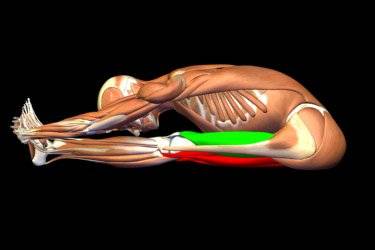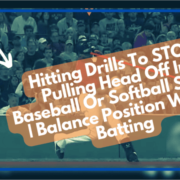Learn hitting drills to STOP pulling your head off the baseball or softball. Discover a more balanced swing position when batting.
Batting Practice Secrets To Fix Swinging Too Hard
Batting practice and training seems to be met with a caveman’s mentality…Me see ball. Me swing bat hard. Me crush ball far. I can always tell when a young hitter is swinging too hard by the following:
- Pulling the head,
- A clenched jaw, and/or
- NO balance upon the follow through.
One great Big League example of caveman swinging is Yoenis Cespedes of the Boston Red Sox. In this video, we’re going to talk about how to correct swinging harder:
- Problem with Reciprocal Inhibition relating to improper batting practice,
- Cadence is key, and
- Proprioception and swinging blind…
SCIENCE-BASED TRAINING:
Improve your hitting strategy dramatically by applying human movement principles.
Learn not only how and what to train but also the science behind the methods.
Problem with Reciprocal Inhibition Relating to Improper Batting Practice
Watch this simple demonstration on Reciprocal Inhibition (RI) from a Physical Therapist (start at the 0:38 mark):
Consider this:
- Imagine bicep curling a 25-pound dumbbell…bicep contracts while brain tells muscle on opposite side (tricep) to contract less,
- Now think about holding the same 25-pound dumbbell in mid-curl, arm is at a 90-degree angle, and forearm is parallel to the ground…

The quad (green) contracting more, while the hamstring (red) contracts less in this stretch. Photo courtesy: BandhayYoga.com
What’s happening there on #2 above?
It’s called an isometric muscle contraction, and is when both the bicep and tricep are contracting equally on both sides.
Your brain is smart. One of it’s many jobs is to manage tension around a joint (i.e. the elbow). To protect it. When you have bicep tendinitis, the length-tension relationship is upset. What happens is, the brain tells a muscle to tighten protecting a particular joint, until length-tension balance is restored…
How do you fix this?
According to the Physical Therapist in the above video link, you strengthen the muscles opposite the tight area. The brain can then contract the tight area less and restoring the length-tension relationship around the joint. And this ADDS more efficiency to dynamic movement…
Otherwise, this would be like driving your car with the parking brake on!
During batting practice (or in games), when we swing too hard, we’re driving the car with the parking brake on. It seems counter-intuitive to what we normally would think. But bio-mechanically speaking, this would be like the #2 scenario of the bicep -mid-curl above. We see the head pull out and jaw tighten because the brain is protecting the joints in the neck (C-Spine) and jaw from overload. And this can cause the hitter NOT be balanced in the follow through.
Cadence is Key
Did you know there’s a specific cadence, or tempo, to repetitive human movement? According to the book Chi Running: A Revolutionary Approach to Effortless, Injury-Free Running, by Danny and Katherine Dreyer, consider these two popular long distance movements:
- Running – count how many times the right arm swings forward per minute. It should be between 85-90 times. Whether uphill or downhill.
- Cycling – count each time the right knee floats up per minute while pedaling. Should be 85-90 times. Top cyclists change gears uphill or downhill to keep within these guidelines.
Faster than that, and tempo gets disrupted…parking brake gets applied. Batting practice is no different when it comes to a specific tempo. I once read someone say in a hitting forum that you have to swing as hard as you possibly can…wait for it…under COMPLETE control…
Proprioception & Swinging Blind
I know that’s a big scary word, but experiencing it is easy…stand on one foot, now shut your eyes. You’ve just experienced Proprioception.
The best fix for swinging too hard is…drum roll please….
Swinging with your eyes closed. Remember what I wrote about a hitter swings as hard as possible…under COMPLETE control?
This is how to practice taking the parking brake off during batting practice and games.
Also, remember the symptoms of swinging too hard I mentioned at the beginning of this video post…? Here are the fixes:
- Pulling the head – the chin should be somewhere slightly out front of impact,
- A clenched jaw – get the hitter to keep a small gap between their molars as they’re swinging, AND
- NO balance upon the follow through – have the hitter practice swinging as hard as they can with their eyes closed, while keeping balance. If they fall over, then they’re swinging too hard.
The latter one, please DO NOT have them do this around any sharp or breakable objects that might hurt them :-/ You see, Yoenis Cespedes can win two All-Star home-run derbies in a row because he knows what pitch is coming, at what speed, and what location (for the most part). He can get away from pulling his head. In a game? It’s a different
BONUS Material
Want to help put the batting practice parking brake on vacation? Here are my two favorite corrective exercises that a majority of my new hitters have a problem with:
- Passive Leg Lower (hip mobility) – week one: 1 set X 12 reps each leg, week two: 1 set X 15 reps each leg, week three: 2 sets X 12 reps each leg, and week four: 2 sets X 15 reps each leg…do once daily. Will increase running stride length, which indirectly can help them run faster.
- Ankle Circles (ankle mobility) – do three circles clockwise AND counterclockwise at each ankle position…do at least 2-3 times per day everyday. Can get rid of shin splints and plantar fasciitis.



